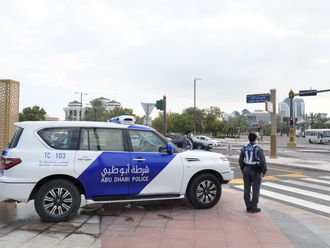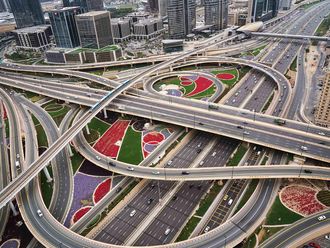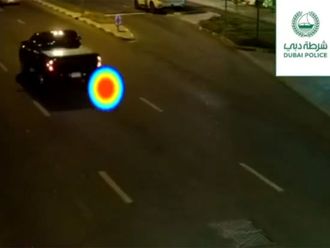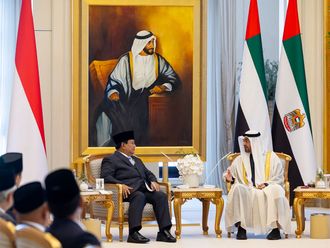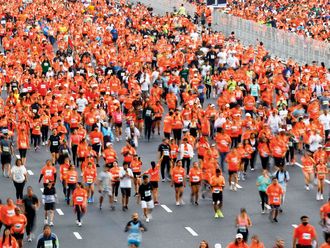Dubai: Dubai authorities are grappling with new ways of keeping the emirate’s skies safe after drones halted air traffic at one of the world’s busiest airports three times last year.
The delays were necessary to protect passengers, officials said, but they hit thousands of travellers and cost airlines millions of dollars.
Drones pose a “threat to the flying public” and “to an aircraft in operation,” said Ismaeil al Blooshi, deputy head of the air safety department of the United Arab Emirates’ civil aviation authority.
He compared drones to the threat posed by birds, but said they were less predictable and harder to avoid.
“We have means and data to predict when and where is the bird migration... but with drones, you have this object in the air and you don’t know the intentions” of the operator, he said.
The cost of closing airspace for one hour runs into millions and creates a long backlog, but there is no room to compromise on safety, Blooshi said.
“The economic impact is not even on the table” when considering the risks, he said. “The number one priority is avoiding harm to passengers.”
Drones have become a more common sight in the skies above the emirate as related technology has plunged in price, with professional photographers eager to use them.
“The drone has helped us all. Before we needed a plane and a big budget to do aerial shooting. It’s much easier and cheaper now,” said videographer Murad al-Masri, as he shot footage of a desert festival.
After last year’s incidents, operator Dubai Airports stressed that flying drones within five kilometres (three miles) of airports was illegal.
New regulations introduced last year stipulate up to three years in jail or a fine of 100,000 dirhams ($27,000, 25,000 euros) for flying a drone over a prohibited zone.
Phone app, geo-fencing
But Dubai-owned carrier Emirates, the world’s busiest international passenger airline, urged authorities to go further, introducing drone detectors.
“Flight diversions and network disruptions due to unauthorised drone activity... cost Emirates airline millions of dirhams on each occasion, and impacted thousands of passengers,” it said after one drone-related delay in November.
Authorities have even examined the possibility of hunting down the devices.
The International Defence Exhibition and Conference, one of the largest arms fairs in the Middle East, on Monday showcased a private company’s drone hunting system.
Dubai-based SkyStream said it had crafted a three-phase system that could identify whether the drones were “friendly,” jam their signals in case they were not and subsequently bring them down.
A security official told AFP Dubai police now have the ability to overpower a drone and bring it down but did not elaborate on how.
The aviation authority has introduced a mobile phone application that clearly marks out no-fly zones for drones across the country, telling users immediately where they can and cannot fly.
Out-of-bounds areas include those around airports, military zones and other government installations.
The authority also wants drone owners to register their devices.
Another measure under study is geo-fencing, meaning that drones are pre-programmed to make them unable to enter restricted areas even if users try to send them there.
“We are talking to various manufacturers to impose this as an import requirement for the UAE,” said Blooshi, although he said this is hard because drones are produced by many different manufacturers.
Authorities in Europe have also scrambled to apply rules on flying drones after mishaps at airports.
Sea rescue drones
“The risk of collision is to be taken seriously,” said Yves Morier of the European Aviation Safety Agency.
“The introduction of drones has to be done in a safe manner,” said Morier, whose agency is to work on common regulations for the European Union.
“There have been incidents in Europe and their number has risen in the past years.”
France has forbidden flying drones within 10 kilometres (six miles) of an airport, the French civil aviation authority says, twice the maximum distance in the UAE.
But while drones can pose risks to aviation, UAE authorities are keen to make use of them for policing, rescue and security purposes.
“We use drones in various aspects, including securing events, detecting explosives and (securing) motorcades” of high profile figures, said Sergeant Abdullah al-Harbi, head of the technical support team at Dubai’s General Department of Protective Security and Emergency.
He said authorities plan to use drones equipped with face detection software to hunt for suspects.
Rescue services in the emirate of Ajman have also deployed drones to help in sea rescue operations, local press has reported.
The drones are equipped with thermal sensors and cameras that scan the waters to locate casualties, and carry buoys that can be dropped to them by remote control.
And the labour ministry has been using drones since 2014 to inspect construction sites and make sure companies are giving workers their compulsory midday break during hot weather.
“Drones are good for us,” said Blooshi. “We are eager to accommodate them in a healthy way.”


